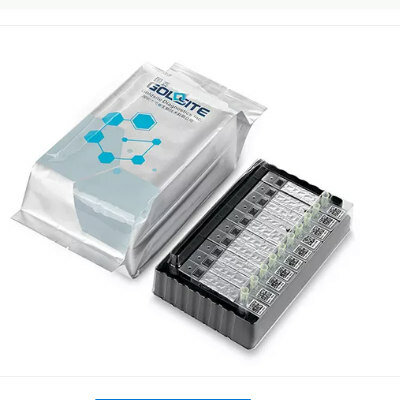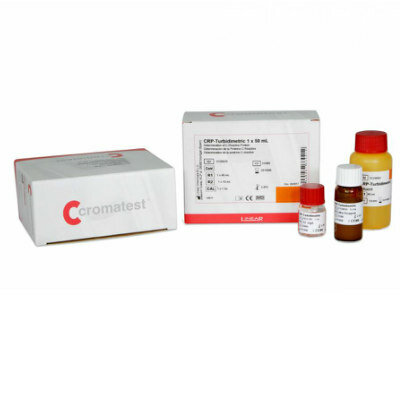Double-Antigen Sandwich ELISA Detects Antibodies to Trypanosoma cruzi
|
By LabMedica International staff writers Posted on 29 Mar 2022 |

Chagas disease (CD), also known as American trypanosomiasis, is a potentially life-threatening vector-borne tropical zoonosis caused by the protozoan parasite Trypanosoma cruzi. The estimated prevalence of CD in 21 Latin American countries where it is considered endemic exceeds five million individuals; CD accounts for approximately 7,500 deaths annually.
Indirect immunoassays are the recommended method for chronic Chagas disease diagnosis and its performance relies on the employed antigen preparation. Chimeric antigens have been successfully utilized for chronic CD in vitro diagnosis and efficiently address commonly encountered hurdles arising from the use of recombinant and native antigens.
A team of Medical Scientists at the Oswaldo Cruz Foundation (Rio de Janeiro, Brazil) and their colleagues developed and evaluated four chimeric antigens from T. cruzi (IBMP-8.1, IBMP-8.2, IBMP-8.3 and IBMP-8.4) using a double-antigen sandwich ELISA (DAgS-ELISA) as the diagnostic platform. To overcome any limitation, peroxidase-labeled (HRP) antigens can be utilized, diagnosing either acute or chronic infection, in a species and immunoglobulin class-independent manner. The team obtained a total of 412 sera from 207 T. cruzi-positive and 205 T. cruzi-negative individuals. Additionally, to evaluate cross-reactivity, 68 sera from individuals with unrelated diseases, as previously defined by parasitological or serological diagnosis, were acquired.
The optimal dilutions of serum and antigen-enzyme conjugate (HRP) were determined by checkerboard titration at different chimeric antigen coating concentrations. Antigens were diluted at the final concentrations of 400 ng, 200 ng, 100 ng, 50 ng, 25 ng, 12.5 ng, 6.25 ng, 3.125 ng and 1.56 ng in carbonate-bicarbonate buffer (50 mM, pH 9.6). These dilutions (100 μL) were placed on 96-well high-binding microplates. Absorbance was measured on a microplate spectrophotometer at a wavelength of 450 nm on a SPECTRAmax 340PC (Molecular Devices, San Jose, CA, USA).
The investigators reported that in the phase I study, the areas under the curve of IBMP-8.1, IBMP-8.2, IBMP-8.3 and IBMP-8.4 were 98.7%, 99.5%, 98.6% and 98.8%, respectively. Among the positive samples, IBMP-8.1 antigen classified 53 (25.6%) as false negative, IBMP-8.2, 27 (13%), IBMP-8.3, 24 (11.6%) and IBMP-8.4, 43 (20.8%), giving sensitivities of 74.4%, 87%, 88.4% and 79.2%, respectively. The only antigen that did not reach 100% specificity was IBMP-8.3, with 96.6%. IBMP-8.3 was also the only molecule to show cross-reactivity with Human T-cell lymphotropic virus (HTLV).
The authors concluded that that IBMP-DAgS-ELISA is suitable for the detection of anti-T. cruzi antibodies in areas of co-endemicity with Leishmania spp. The findings also demonstrate the notable capability of all four IBMP proteins to distinguish between T. cruzi-positive and -negative samples. The specificity attained under DAgS-ELISA reached 100% using three of the four chimeric antigens evaluated, IBMP-8.1, IBMP-8.2 and IBMP-8.4. The study was published on March 11, 2022 in the journal PLOS Neglected Tropical Diseases.
Related Links:
Oswaldo Cruz Foundation
Molecular Devices
Latest Immunology News
- Diagnostic Blood Test for Cellular Rejection after Organ Transplant Could Replace Surgical Biopsies
- AI Tool Precisely Matches Cancer Drugs to Patients Using Information from Each Tumor Cell
- Genetic Testing Combined With Personalized Drug Screening On Tumor Samples to Revolutionize Cancer Treatment
- Testing Method Could Help More Patients Receive Right Cancer Treatment
- Groundbreaking Test Monitors Radiation Therapy Toxicity in Cancer Patients
- State-Of-The Art Techniques to Investigate Immune Response in Deadly Strep A Infections
- Novel Immunoassays Enable Early Diagnosis of Antiphospholipid Syndrome
- New Test Could Predict Immunotherapy Success for Broader Range Of Cancers
- Simple Blood Protein Tests Predict CAR T Outcomes for Lymphoma Patients
- Cell Sorter Chip Technology to Pave Way for Immune Profiling at POC
- Chip Monitors Cancer Cells in Blood Samples to Assess Treatment Effectiveness
- Automated Immunohematology Approaches Can Resolve Transplant Incompatibility
- AI Leverages Tumor Genetics to Predict Patient Response to Chemotherapy
- World’s First Portable, Non-Invasive WBC Monitoring Device to Eliminate Need for Blood Draw
- Predictive T-Cell Test Detects Immune Response to Viruses Even Before Antibodies Form
- Single Blood Draw to Detect Immune Cells Present Months before Flu Infection Can Predict Symptoms
Channels
Clinical Chemistry
view channel
3D Printed Point-Of-Care Mass Spectrometer Outperforms State-Of-The-Art Models
Mass spectrometry is a precise technique for identifying the chemical components of a sample and has significant potential for monitoring chronic illness health states, such as measuring hormone levels... Read more.jpg)
POC Biomedical Test Spins Water Droplet Using Sound Waves for Cancer Detection
Exosomes, tiny cellular bioparticles carrying a specific set of proteins, lipids, and genetic materials, play a crucial role in cell communication and hold promise for non-invasive diagnostics.... Read more
Highly Reliable Cell-Based Assay Enables Accurate Diagnosis of Endocrine Diseases
The conventional methods for measuring free cortisol, the body's stress hormone, from blood or saliva are quite demanding and require sample processing. The most common method, therefore, involves collecting... Read moreMolecular Diagnostics
view channel
Unique Autoantibody Signature to Help Diagnose Multiple Sclerosis Years before Symptom Onset
Autoimmune diseases such as multiple sclerosis (MS) are thought to occur partly due to unusual immune responses to common infections. Early MS symptoms, including dizziness, spasms, and fatigue, often... Read more
Blood Test Could Detect HPV-Associated Cancers 10 Years before Clinical Diagnosis
Human papilloma virus (HPV) is known to cause various cancers, including those of the genitals, anus, mouth, throat, and cervix. HPV-associated oropharyngeal cancer (HPV+OPSCC) is the most common HPV-associated... Read moreHematology
view channel
Next Generation Instrument Screens for Hemoglobin Disorders in Newborns
Hemoglobinopathies, the most widespread inherited conditions globally, affect about 7% of the population as carriers, with 2.7% of newborns being born with these conditions. The spectrum of clinical manifestations... Read more
First 4-in-1 Nucleic Acid Test for Arbovirus Screening to Reduce Risk of Transfusion-Transmitted Infections
Arboviruses represent an emerging global health threat, exacerbated by climate change and increased international travel that is facilitating their spread across new regions. Chikungunya, dengue, West... Read more
POC Finger-Prick Blood Test Determines Risk of Neutropenic Sepsis in Patients Undergoing Chemotherapy
Neutropenia, a decrease in neutrophils (a type of white blood cell crucial for fighting infections), is a frequent side effect of certain cancer treatments. This condition elevates the risk of infections,... Read more
First Affordable and Rapid Test for Beta Thalassemia Demonstrates 99% Diagnostic Accuracy
Hemoglobin disorders rank as some of the most prevalent monogenic diseases globally. Among various hemoglobin disorders, beta thalassemia, a hereditary blood disorder, affects about 1.5% of the world's... Read moreMicrobiology
view channel
Mouth Bacteria Test Could Predict Colon Cancer Progression
Colon cancer, a relatively common but challenging disease to diagnose, requires confirmation through a colonoscopy or surgery. Recently, there has been a worrying increase in colon cancer rates among younger... Read more.jpg)
Unique Metabolic Signature Could Enable Sepsis Diagnosis within One Hour of Blood Collection
Sepsis is a life-threatening condition triggered by an extreme response of the body to an infection. It requires immediate medical intervention to prevent potential death or lasting damage.... Read morePathology
view channel
Spatial Tissue Analysis Identifies Patterns Associated With Ovarian Cancer Relapse
High-grade serous ovarian carcinoma is the most lethal type of ovarian cancer, and it poses significant detection challenges. Typically, patients initially respond to surgery and chemotherapy, but the... Read more.jpg)
Unique Hand-Warming Technology Supports High-Quality Fingertip Blood Sample Collection
Warming the hand is an effective way to facilitate blood collection from a fingertip, yet off-the-shelf solutions often do not fulfill laboratory requirements. Now, a unique hand-warming technology has... Read moreTechnology
view channel
New Diagnostic System Achieves PCR Testing Accuracy
While PCR tests are the gold standard of accuracy for virology testing, they come with limitations such as complexity, the need for skilled lab operators, and longer result times. They also require complex... Read more
DNA Biosensor Enables Early Diagnosis of Cervical Cancer
Molybdenum disulfide (MoS2), recognized for its potential to form two-dimensional nanosheets like graphene, is a material that's increasingly catching the eye of the scientific community.... Read more
Self-Heating Microfluidic Devices Can Detect Diseases in Tiny Blood or Fluid Samples
Microfluidics, which are miniature devices that control the flow of liquids and facilitate chemical reactions, play a key role in disease detection from small samples of blood or other fluids.... Read more
Breakthrough in Diagnostic Technology Could Make On-The-Spot Testing Widely Accessible
Home testing gained significant importance during the COVID-19 pandemic, yet the availability of rapid tests is limited, and most of them can only drive one liquid across the strip, leading to continued... Read moreIndustry
view channel
ECCMID Congress Name Changes to ESCMID Global
Over the last few years, the European Society of Clinical Microbiology and Infectious Diseases (ESCMID, Basel, Switzerland) has evolved remarkably. The society is now stronger and broader than ever before... Read more
Bosch and Randox Partner to Make Strategic Investment in Vivalytic Analysis Platform
Given the presence of so many diseases, determining whether a patient is presenting the symptoms of a simple cold, the flu, or something as severe as life-threatening meningitis is usually only possible... Read more
Siemens to Close Fast Track Diagnostics Business
Siemens Healthineers (Erlangen, Germany) has announced its intention to close its Fast Track Diagnostics unit, a small collection of polymerase chain reaction (PCR) testing products that is part of the... Read more
















